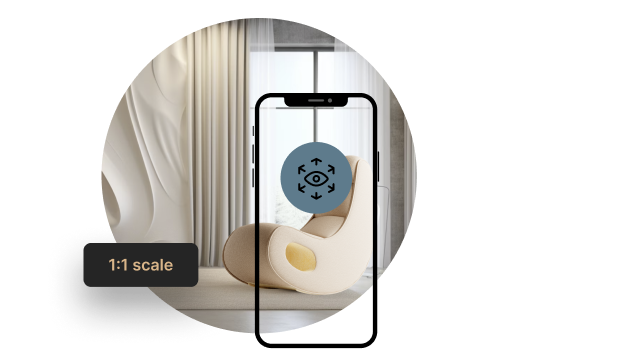The Ultimate 2025 Sofa Configuration Guide
Get your free copy todayy!

Augmented Reality (AR) is rapidly becoming an essential tool for businesses aiming to capture customer attention and deliver an exceptional shopping experience. By 2025, nearly 75% of the global population, including almost all users of social and communication apps, will be frequent AR users. This makes AR a powerful way to stand out in the crowded e-commerce market and drive conversions.
Here are five ways to leverage augmented reality as a significant value-add in your online store, showroom, or overall customer communication strategy:
Do you think an AR experience would be useful to your clients? According to Shopify, interactions with products featuring AR content lead to a 94% higher conversion rate compared to products without AR. Imagine a customer browsing your online store and virtually trying on clothing or seeing how a piece of furniture would look in their living room before purchasing. This level of interactivity can significantly boost conversions and reduce returns.
Although web AR may seem cutting-edge, implementing it in an online store is simpler than it appears. All you need is a 3D model of the product or a photo of an image or poster. The next step is converting the file to AR formats (USDZ for iOS or GLB for Android) and embedding it on the store’s website as a button or widget. Most importantly, web AR doesn’t require downloading external applications, ensuring a smooth shopping experience. There are also more advanced uses of AR in e-commerce, such as virtual try-ons, animations, or displaying personalized products.
In-store customers can use AR to display additional product information, reviews, or other variants. If there’s something missing in your physical store, AR can address it effectively. You can use webAR to highlight specific products, features, or even build brand awareness. For instance, cosmetics brands use AR sampling devices in drugstores to enable customers to virtually try on lipsticks without physically applying the product. A mineral water producer might use AR to showcase the history of the water source and its mineral composition.
To drive foot traffic, you can also add AR to your storefront displays. For example, Harrods used AR in their Christmas windows to add an extra dimension to their storefront, attracting more customers.
Brands can use AR effects on social media to increase customer interaction, boost product awareness, and generate word-of-mouth. Platforms like Snapchat, TikTok, Instagram, and Facebook offer various AR features, including product visualizations, mini-games, and virtual try-ons. Imagine a customer scrolling through Instagram and virtually trying on a pair of sunglasses or seeing a product in action—this level of engagement can drive sales.
According to Snapchat, over 250 million people engage with AR on the platform daily. Snapchat has broad mobile reach among Gen Z and millennials and is recognized as an AR-friendly platform. On the other hand, Instagram and Facebook cater to a wide range of demographics and offer AR features like Stories, product visualizations, mini-games, image trackers, and virtual try-ons. TikTok, which is rapidly growing, is especially popular among younger users. TikTok’s dedicated AR effects tool, Effect House, allows users and brands to create AR filters, such as face masks, funny distortions, animated backgrounds, and AR games.
For example, Coca-Cola used AR on Snapchat to promote its Coke Summer Music events, creating an engaging and interactive experience for users.
Augmented Reality (AR) is a powerful tool for creating engaging and interactive marketing campaigns. By incorporating AR into your marketing strategy, you can distinguish your product and educate customers about its features in a fun and memorable way. The process is simple—customers scan a product, packaging, or QR code with their smartphone to trigger an AR experience. This opens up a world of possibilities for enhancing the customer experience and showcasing your product in a new and exciting way. For example, AR can reveal additional product features or animations that bring your product to life. By providing a unique and immersive experience, AR can help build brand awareness, increase customer engagement, and ultimately drive sales. So, if you’re looking to stand out in the crowded marketplace, consider incorporating AR into your next marketing campaign.
AR can be used to entertain, enhance, or create a great post-purchase experience for customers. For example, integrating AR into newsletters, post-purchase communication, or holiday messages can make them more engaging and memorable. Here are some examples:
In conclusion, AR is an excellent tool for businesses to capture customer attention, provide an outstanding shopping experience, and drive conversions. By using web AR in e-commerce, physical stores, or social media, brands can differentiate themselves from the competition and build stronger relationships with their customers.

